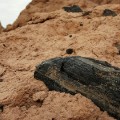

So I agree that the apex width alone isn’t relevant when discussing cutting ability. It is my understanding that the apex width itself is what initiates the cut and the initial piercing of the material, but all the metal behind the apex is what determines how well that specific blade will cut. I think Todd (that’s his name – below) answered this well.

(And this is even apart from measurement apparatus – unless you’ve got an electron microscope – and my hands simply not being exact enough to measure consistently at the same location for every knife.) This is the reason that in my Japanese Kitchen knife Reviews blog I measure the edge thickness only at 5 mm above the edge. So how can the concept of apex width make sense without saying where you measure the width. If you do it just half a millimeter lower, it will already be much thicker. For example, if you do it at the exact top you might end up with a few molecules’ width. Josh, maybe I should better ask this question at the guy of Science of Sharp (sorry, forgot his name), but how can you exactly measure the width of an apex? I.e. Where they show amateurish SEM images of their product vs the competition and where the steel scalpel is coated with teflon, so you can’t even see the apex. Your image reminds me of another BS marketing photo from Diamond microtomes are very keen, but the bevel angle is too high to cut anything but thin, flexible sections, and if the bevel angle were lower, they would be even more fragile than they already are. I can make a carbon steel straight razor sharper than a diamond microtome or obsidian scalpel, but the question is whether it will perform better for a particular application. What is more important is whether the blade can make the cut without being chipped or folded. The “crystalline elements” – carbide dimensions and grain size are much larger than the edge width of a straight razor or surgical scalpel. The edges are not sharpened, they are made using fracture lines. That’s how fine we’re talking when it comes to the obsidian and diamond knives. The diamond knives of ultramicrotomy are used to create 2000 radial cross sections of a single hair, or 100 cross sections of a single red blood cell. It’s basically the works of ultramicrotomy starting to bridge into surgery.

Grinding geometry and suture needle attachment are directed toward frictionless tissue penetration.Without getting too much further into it, you’re also looking at the crystalline structure of the elements evolved beyond the sharpening when it comes to the obsidian vs steel argument. Superfine round tip with flattened body to improve stability in needle holder. Stainless steel needle honed under microscope by hand. Nylon is suitable for closing ophthalmic, neurological and microvascular wounds. Needle and thread combination comprising of non-absorbable black nylon polyamide monofilament thread and stainless steel 3/8 circle needle. The suture-to-needle attachment is tested to higher standards than the USP specifications. They are inspected under the microscope at critical stages during the manufacturing process, and a multi-point final inspection of each suture and needle combination ensures a high quality product. FST microsurgical needles provide frictionless tissue penetration. The combination of proprietary needle design technology and state-of-the-art manufacturing techniques has enabled FST to provide a microsurgical needle that is unmatched in the industry. TR-200 Temperature Controller & Accessories.


 0 kommentar(er)
0 kommentar(er)
